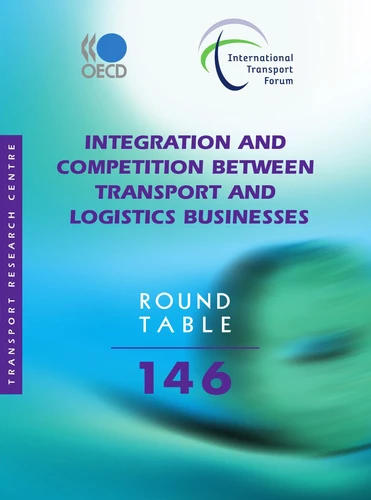Integration and Competition between Transport and Logistics Businesses
Par :Formats :
Disponible dans votre compte client Decitre ou Furet du Nord dès validation de votre commande. Le format Multi-format est :
- Pour les liseuses autres que Vivlio, vous devez utiliser le logiciel Adobe Digital Edition. Non compatible avec la lecture sur les liseuses Kindle, Remarkable et Sony
 , qui est-ce ?
, qui est-ce ?Notre partenaire de plateforme de lecture numérique où vous retrouverez l'ensemble de vos ebooks gratuitement
Pour en savoir plus sur nos ebooks, consultez notre aide en ligne ici
- Nombre de pages184
- FormatMulti-format
- ISBN978-92-821-0261-9
- EAN9789282102619
- Date de parution26/02/2010
- Protection num.NC
- Infos supplémentairesMulti-format incluant PDF avec W...
- ÉditeurOECD
Résumé
Some very large multinational transport and logistics firms have emerged to provide integrated transport services to shippers in the globalised economy. Do these firms escape regulatory oversight from national competition authorities because of their sheer scale? Do they pose additional threats to competition when they merge with or acquire other companies in the supply chain?
The Round Table brought competition experts together with researchers on maritime shipping, rail freight and logistics to identify critical competition issues and appropriate regulatory responses.
An examination of the strategies of transport and logistics companies reveals that vertical integration can yield efficiencies, but usually reflects a need to improve the use of expensive fixed assets rather than control all parts of the supply chain. This usually explains why shipping lines acquire terminal operators. Horizontal acquisitions, where similar companies serving the same market merge, are more likely to raise competition concerns.
Problems are particularly prone to arise at bottleneck infrastructure facilities. The Round Table report provides an economic framework for examining competition in global transport and logistics businesses, discusses the adequacy of the remedies available to regulators when competition is threatened, and explores the role of competition authorities and Transport Ministries in ensuring markets are efficient.
An examination of the strategies of transport and logistics companies reveals that vertical integration can yield efficiencies, but usually reflects a need to improve the use of expensive fixed assets rather than control all parts of the supply chain. This usually explains why shipping lines acquire terminal operators. Horizontal acquisitions, where similar companies serving the same market merge, are more likely to raise competition concerns.
Problems are particularly prone to arise at bottleneck infrastructure facilities. The Round Table report provides an economic framework for examining competition in global transport and logistics businesses, discusses the adequacy of the remedies available to regulators when competition is threatened, and explores the role of competition authorities and Transport Ministries in ensuring markets are efficient.
Some very large multinational transport and logistics firms have emerged to provide integrated transport services to shippers in the globalised economy. Do these firms escape regulatory oversight from national competition authorities because of their sheer scale? Do they pose additional threats to competition when they merge with or acquire other companies in the supply chain?
The Round Table brought competition experts together with researchers on maritime shipping, rail freight and logistics to identify critical competition issues and appropriate regulatory responses.
An examination of the strategies of transport and logistics companies reveals that vertical integration can yield efficiencies, but usually reflects a need to improve the use of expensive fixed assets rather than control all parts of the supply chain. This usually explains why shipping lines acquire terminal operators. Horizontal acquisitions, where similar companies serving the same market merge, are more likely to raise competition concerns.
Problems are particularly prone to arise at bottleneck infrastructure facilities. The Round Table report provides an economic framework for examining competition in global transport and logistics businesses, discusses the adequacy of the remedies available to regulators when competition is threatened, and explores the role of competition authorities and Transport Ministries in ensuring markets are efficient.
An examination of the strategies of transport and logistics companies reveals that vertical integration can yield efficiencies, but usually reflects a need to improve the use of expensive fixed assets rather than control all parts of the supply chain. This usually explains why shipping lines acquire terminal operators. Horizontal acquisitions, where similar companies serving the same market merge, are more likely to raise competition concerns.
Problems are particularly prone to arise at bottleneck infrastructure facilities. The Round Table report provides an economic framework for examining competition in global transport and logistics businesses, discusses the adequacy of the remedies available to regulators when competition is threatened, and explores the role of competition authorities and Transport Ministries in ensuring markets are efficient.


















